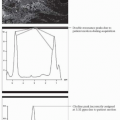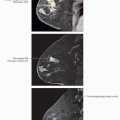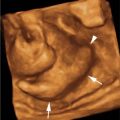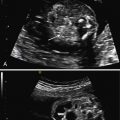Cosmetic Injection
Shih-chang (Ming) Wang, FRANZCR
Terminology
Abbreviations
Polyacrylamide gel (PAAG)
Definitions
Injection of oil, gel, or autologous fat into breast for cosmetic augmentation
Any cosmetic injection may result in foreign body granulomatous reaction or secondary infection
Typically performed in smaller clinics and beauty parlors
Paraffin from early 20th century, silicone since 1960s
Widespread once, now illegal in USA; still used in some parts of world (e.g., Asia, Mexico)
PAAG since late 1990s
Jelly-like transparent gel: 95-97.5% water and 2.5-5 % polyacrylamide, typical volume 150-200 mL
Used for gel electrophoresis, ophthalmic operations, drug treatment, food packaging, water purification
Used in plastic and aesthetic surgery since early 1990s (e.g., faciomaxillary reconstruction)
Used for breast augmentation since 1997
Anatomy-Based Imaging Issues
Overview
Appears as discrete blobs or confluent collections depending on injection technique, location
Intraparenchymal or retroglandular; may be periglandular
Imaging Recommendations
T1W, T2W images, fat suppression
Contrast-enhanced MR if inflammation or infection suspected clinically
MR Features
Signal Characteristics
T1W image
Paraffin, silicone, PAAG: Mildly hypointense
Signal may be increased in secondary infection
Injected fat: High-signal mass(es)
T2W image
Paraffin, silicone, PAAG: Hyperintense heterogeneous collections
Injected fat: High- or intermediate-signal mass(es)
T2W FS image, STIR
Paraffin, silicone, PAAG: Hyperintense
Injected fat may have normal or abnormal fat signal and thus variable degrees of suppression
Inflammation may appear hyperintense
Necrotic fat injections may show high signal fluid-filled cysts, especially if single large injection
T1W C+ image
Granulomas show variable enhancement
Rim enhancement around collections especially if inflammatory changes
Enhancement kinetics
Slow, with prolonged delayed enhancement
Resonant frequencies differ for each injected material
Differential Diagnosis
Other Fluid Collections
Silicone implant
Seroma or lymphocele
Abscess/infection
Clinical Considerations
Presentation
Usually focal or diffuse lumps, hardening, deformity
Inflammation or frank infection, especially with PAAG, fat injections
Discomfort or pain
Silicone mastitis may have draining sinuses, ulceration, deformity
Demographics
Predominantly Asian patients, also Eastern European
Also reported in male transsexuals
Implications and Management
Prognosis
Long-term adverse consequences unknown
No known association with breast cancer or collagen vascular disease
Management
Infection and scarring may require local surgical removal or mastectomy in extreme cases
May impair ability to perform routine breast cancer screening
Selected References
1. Hyakusoku H et al: Complications after autologous fat injection to the breast. Plast Reconstr Surg. 123(1):360-70; discussion 371-2, 2009
2. Lui CY et al: Evaluation of MRI findings after polyacrylamide gel injection for breast augmentation. AJR Am J Roentgenol. 191(3):677-88, 2008
3. Teo SY et al: Radiologic features of polyacrylamide gel mammoplasty. AJR Am J Roentgenol. 191(3):W89-95, 2008
4. Erguvan-Dogan B et al: Direct injection of paraffin into the breast: mammographic, sonographic, and MRI features of early complications. AJR Am J Roentgenol. 186(3):888-94, 2006
5. Qiao Q et al: Management for postoperative complications of breast augmentation by injected polyacrylamide hydrogel. Aesthetic Plast Surg. 29(3):156-61; discussion 162, 2005
6. Christensen LH et al: Long-term effects of polyacrylamide hydrogel on human breast tissue. Plast Reconstr Surg. 111(6):1883-90, 2003
7. Cheung YC et al: Lumpy silicone-injected breasts: enhanced MRI and microscopic correlation. Clin Imaging. 26(6):397-404, 2002
Stay updated, free articles. Join our Telegram channel

Full access? Get Clinical Tree








